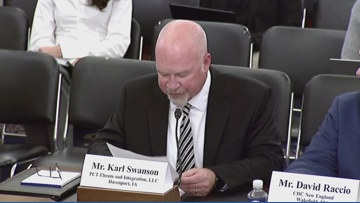
Enriching Undergraduate Academic Experience at Pitt
 At Pitt, we are committed to enriching every undergraduate’s academic experience with transformative opportunities to learn, grow, and thrive without increased financial burden or time to degree. To further this ambitious goal, the Office of the Provost and Academic Leadership Team has convened a task force comprised of faculty, advisors, staff, and students from across all schools and campuses.
At Pitt, we are committed to enriching every undergraduate’s academic experience with transformative opportunities to learn, grow, and thrive without increased financial burden or time to degree. To further this ambitious goal, the Office of the Provost and Academic Leadership Team has convened a task force comprised of faculty, advisors, staff, and students from across all schools and campuses.
Reviewing Student Learning Outcomes and General Education Curricula
In consultation with internal and national experts, this group will review existing University-wide student learning outcomes and all current general education curricula to recommend a more integrative and unified model for adoption across schools and campuses. This project aspires to develop a curriculum and learning outcomes—as described in the Plan for Pitt—that are unified, measurable, and flexible while encouraging “student skill development in areas such as critical thinking, communication, leadership, data analysis, intercultural and global competency, and collaboration.”
Collaborative Approach to Education
The task force will embrace the opportunity to work collaboratively with faculty, students, staff, alumni, and community partners to explore what it means to educate students as “liberated human beings—people who are independent and flexible in their thinking and capable of responding to the demands of a changing world in ways that are deliberate and civic-minded” (General Education Essentials, Paul Hanstedt).
Key Objectives
Key objectives will include:
- Redefining the 2006 Council of Deans vision of overarching Pitt learning outcomes
- Assessing the viability of a unified set of general education requirements across all undergraduate schools and campuses
It should be noted that engaging in this endeavor does not preclude individual units from requiring “extended” general education requirements within a specific school to meet the needs of their unit, but instead would assure that the (minimal set of) foundational requirements across all units are consistent and transferable across the University.
Read Motivations and Opportunities for additional information about the task force vision.
SDGs, Targets, and Indicators in the Article
1. Which SDGs are addressed or connected to the issues highlighted in the article?
- SDG 4: Quality Education
- SDG 8: Decent Work and Economic Growth
- SDG 10: Reduced Inequalities
- SDG 16: Peace, Justice, and Strong Institutions
The article discusses the commitment of the University of Pittsburgh to enriching undergraduate academic experiences without increasing financial burden or time to degree. This aligns with SDG 4, which aims to ensure inclusive and equitable quality education and promote lifelong learning opportunities for all. The article also mentions the development of student skills such as critical thinking, communication, leadership, and intercultural and global competency, which are essential for decent work and economic growth (SDG 8). Additionally, the focus on providing consistent and transferable general education requirements across all units of the university contributes to reducing inequalities (SDG 10) and promoting strong institutions (SDG 16).
2. What specific targets under those SDGs can be identified based on the article’s content?
- Target 4.3: By 2030, ensure equal access for all women and men to affordable and quality technical, vocational, and tertiary education, including university.
- Target 8.6: By 2020, substantially reduce the proportion of youth not in employment, education, or training.
- Target 10.2: By 2030, empower and promote the social, economic, and political inclusion of all, irrespective of age, sex, disability, race, ethnicity, origin, religion, or economic or other status.
- Target 16.7: Ensure responsive, inclusive, participatory, and representative decision-making at all levels.
Based on the article’s content, the specific targets that can be identified are:
– Target 4.3: The University of Pittsburgh aims to provide affordable and quality education to all undergraduate students.
– Target 8.6: The university’s commitment to enriching academic experiences without increasing financial burden or time to degree contributes to reducing the proportion of youth not in employment, education, or training.
– Target 10.2: The university’s efforts to develop a unified set of general education requirements across all undergraduate schools and campuses promote social and economic inclusion by ensuring consistency and transferability.
– Target 16.7: The task force’s collaborative approach involving faculty, students, staff, alumni, and community partners aligns with the goal of inclusive and representative decision-making.
3. Are there any indicators mentioned or implied in the article that can be used to measure progress towards the identified targets?
Yes, there are indicators mentioned or implied in the article that can be used to measure progress towards the identified targets. However, the article does not provide specific quantitative indicators. To measure progress towards the identified targets, indicators could include:
– Increase in the number of undergraduate students accessing affordable and quality education.
– Decrease in the proportion of undergraduate students facing financial burden or extended time to degree.
– Evaluation of the consistency and transferability of general education requirements across all undergraduate schools and campuses.
– Assessment of the level of collaboration and inclusivity in decision-making processes.
SDGs, Targets, and Indicators Table
| SDGs | Targets | Indicators |
|---|---|---|
| SDG 4: Quality Education | Target 4.3: By 2030, ensure equal access for all women and men to affordable and quality technical, vocational, and tertiary education, including university. | Increase in the number of undergraduate students accessing affordable and quality education. |
| SDG 8: Decent Work and Economic Growth | Target 8.6: By 2020, substantially reduce the proportion of youth not in employment, education, or training. | Decrease in the proportion of undergraduate students facing financial burden or extended time to degree. |
| SDG 10: Reduced Inequalities | Target 10.2: By 2030, empower and promote the social, economic, and political inclusion of all, irrespective of age, sex, disability, race, ethnicity, origin, religion, or economic or other status. | Evaluation of the consistency and transferability of general education requirements across all undergraduate schools and campuses. |
| SDG 16: Peace, Justice, and Strong Institutions | Target 16.7: Ensure responsive, inclusive, participatory, and representative decision-making at all levels. | Assessment of the level of collaboration and inclusivity in decision-making processes. |
Copyright: Dive into this article, curated with care by SDG Investors Inc. Our advanced AI technology searches through vast amounts of data to spotlight how we are all moving forward with the Sustainable Development Goals. While we own the rights to this content, we invite you to share it to help spread knowledge and spark action on the SDGs.
Fuente: provost.pitt.edu

Join us, as fellow seekers of change, on a transformative journey at https://sdgtalks.ai/welcome, where you can become a member and actively contribute to shaping a brighter future.






